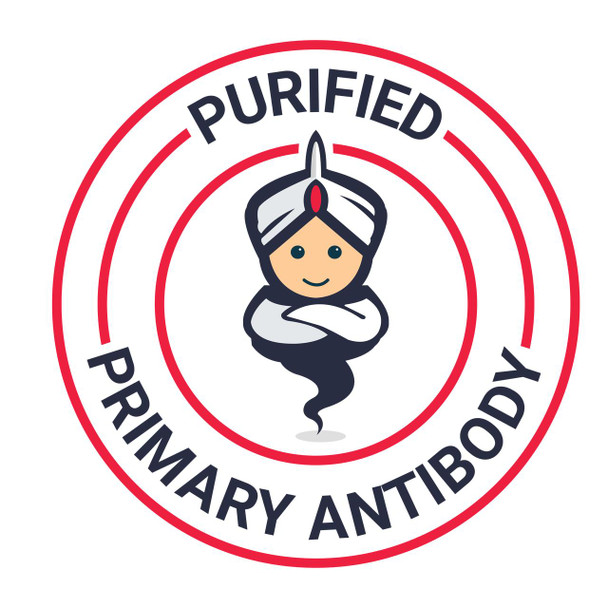Description
| Product Name: | CD105 monoclonal antibody (APC ) |
| Product Code: | AGIM0076 |
| Size: | 500 µL |
| Reactivity: | Human |
| Clone: | MEM-226 |
| Applications: | Flow Cytometry |
| Conjugate: | APC |
| Isotype: | IgG2a |
| Host Species: | Mouse |
| Storage: | Store at 4°C. Avoid prolonged exposure to light. |
| Uniprot: | P17813 |
| Background: | CD105 (Endoglin) is a homodimeric transmembrane glycoprotein serving in presence of TGF??R-2 as a receptor for TGF??-1 and TGF??-3. CD105 is highly expressed on endothelial cells and promotes angiogenesis during wound healing, infarcts and in a wide range of tumours and its gene expression is stimulated by hypoxia. CD105 prevents apoptosis in hypoxic endothelial cells and also antagonises the inhibitory effects of TGF??-1 on vascular endothelial cell growth and migration. Normal cellular levels of CD105 are required for formation of new blood vessels. |
| UniProt Protein Function: | ENG: Major glycoprotein of vascular endothelium. May play a critical role in the binding of endothelial cells to integrins and/or other RGD receptors. Homodimer that forms an heteromeric complex with the signaling receptors for transforming growth factor-beta: TGFBR1 and/or TGFBR2. It is able to bind TGF-beta 1, and 3 efficiently and TGF-beta 2 less efficiently. Interacts with TCTEX1D4. Interacts with ARRB2. Endoglin is restricted to endothelial cells in all tissues except bone marrow. 2 isoforms of the human protein are produced by alternative splicing. |
| UniProt Protein Details: | Protein type:Motility/polarity/chemotaxis; Receptor, misc.; Membrane protein, integral Chromosomal Location of Human Ortholog: 9q34.11 Cellular Component: cytoplasm; external side of plasma membrane; extracellular space; focal adhesion; nucleoplasm; receptor complex Molecular Function:activin binding; galactose binding; glycosaminoglycan binding; protein binding; punt binding; transforming growth factor beta binding; transforming growth factor beta receptor, cytoplasmic mediator activity Biological Process: artery morphogenesis; BMP signaling pathway; central nervous system vasculogenesis; heart looping; negative regulation of cell migration; negative regulation of protein amino acid autophosphorylation; patterning of blood vessels; positive regulation of BMP signaling pathway; positive regulation of protein amino acid phosphorylation; regulation of transcription, DNA-dependent; regulation of transforming growth factor beta receptor signaling pathway; smooth muscle development; vasculogenesis; venous blood vessel morphogenesis Disease: Telangiectasia, Hereditary Hemorrhagic, Of Rendu, Osler, And Weber |
| NCBI Summary: | This gene encodes a homodimeric transmembrane protein which is a major glycoprotein of the vascular endothelium. This protein is a component of the transforming growth factor beta receptor complex and it binds to the beta1 and beta3 peptides with high affinity. Mutations in this gene cause hereditary hemorrhagic telangiectasia, also known as Osler-Rendu-Weber syndrome 1, an autosomal dominant multisystemic vascular dysplasia. This gene may also be involved in preeclampsia and several types of cancer. Alternatively spliced transcript variants encoding different isoforms have been found for this gene. [provided by RefSeq, May 2013] |
| UniProt Code: | P17813 |
| NCBI GenInfo Identifier: | 3041681 |
| NCBI Gene ID: | 2022 |
| NCBI Accession: | P17813.2 |
| UniProt Secondary Accession: | P17813,Q14248, Q14926, Q5T9C0, |
| UniProt Related Accession: | P17813 |
| Molecular Weight: | 67,542 Da |
| NCBI Full Name: | Endoglin |
| NCBI Synonym Full Names: | endoglin |
| NCBI Official Symbol: | ENG |
| NCBI Official Synonym Symbols: | END; HHT1; ORW1 |
| NCBI Protein Information: | endoglin |
| UniProt Protein Name: | Endoglin |
| UniProt Synonym Protein Names: | CD_antigen: CD105 |
| Protein Family: | Endoglin |
| UniProt Gene Name: | ENG |
| UniProt Entry Name: | EGLN_HUMAN |






